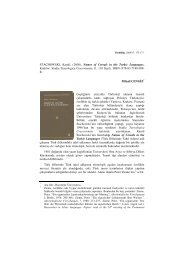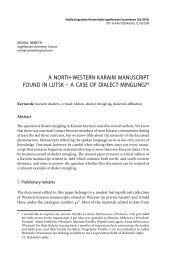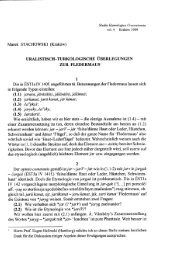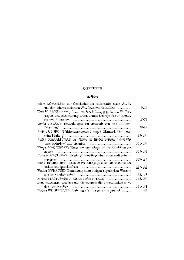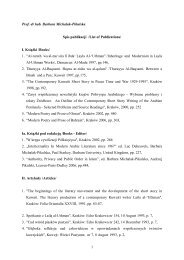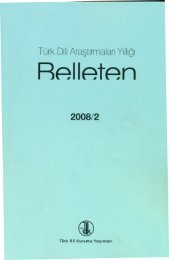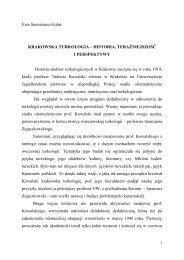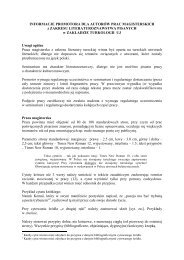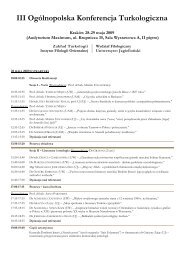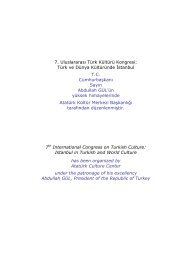Names of Cereals in the Turkic Languages - Wydział Filologiczny UJ
Names of Cereals in the Turkic Languages - Wydział Filologiczny UJ
Names of Cereals in the Turkic Languages - Wydział Filologiczny UJ
- No tags were found...
You also want an ePaper? Increase the reach of your titles
YUMPU automatically turns print PDFs into web optimized ePapers that Google loves.
yesecale cereale l.Rye is a secondary cultivable plant (formed from a weed), and is still found as a weed <strong>in</strong>some parts <strong>of</strong> <strong>the</strong> world, especially <strong>in</strong> <strong>the</strong> Indoch<strong>in</strong>ese and Central Asian Centres. Itsrequirements are ra<strong>the</strong>r moderate, allow<strong>in</strong>g it to dom<strong>in</strong>ate <strong>in</strong> mounta<strong>in</strong>ous areas and <strong>in</strong>low quality soils, but it tends to be displaced by o<strong>the</strong>r plants <strong>in</strong> more fertile lands.Rye probably orig<strong>in</strong>ates from <strong>the</strong> area <strong>of</strong> Asia M<strong>in</strong>or, Iran and Armenia. Numerousprimitive taxons with clearly weed-like features can still be found <strong>in</strong> <strong>the</strong> region and itssurround<strong>in</strong>gs. They surely can not have been ever been domesticated before as <strong>the</strong>re neverexisted <strong>in</strong>tentional cultivations <strong>of</strong> pure rye <strong>in</strong> this part <strong>of</strong> <strong>the</strong> world.Seeds <strong>of</strong> rye turn out to be stronger when mixed with <strong>the</strong> seeds <strong>of</strong> o<strong>the</strong>r cereals. InCentral Europe mix<strong>in</strong>g equal amounts <strong>of</strong> rye and wheat, and <strong>the</strong>n cont<strong>in</strong>uously seed<strong>in</strong>gwith <strong>the</strong> material <strong>of</strong> <strong>the</strong> same orig<strong>in</strong>, results <strong>in</strong> nearly pure rye harvests <strong>in</strong> just a couple <strong>of</strong>years. It is probably this feature, <strong>in</strong> connection with a very old tradition <strong>of</strong> seed<strong>in</strong>g mixtures<strong>of</strong> seeds ra<strong>the</strong>r than pure species, that gave birth to legends (Tkc., among o<strong>the</strong>rs) <strong>of</strong> gradualchange (a deterioration) <strong>of</strong> wheat <strong>in</strong>to rye. (Nowiński 1970: 176–79.)The relatively few names and <strong>the</strong>ir character (borrow<strong>in</strong>gs and descriptive names) showthat rye has never been a particularly important plant for <strong>the</strong> Tkc. peoples. Presumably,it was treated, as it still <strong>of</strong>ten is <strong>in</strong> Asia, more as a weed than a cultivable plant.forms:ārəš → aryšărša → aryšarsānajarys → aryšaryšaryš bidaj → aryšarǯanaj → arsānajarǯanaj tarā → arsānajarǯanaj taryg → arsānajasłykašłych → asłykčadagan → jadygančadygan → jadygančavdarčavdary → čavdarčovdar → čavdarčovdary → čavdarčovdor → čavdardargan → darikandarikandarkān → darikanjadagan → jadyganjadyganjadygan aryš → jadyganjatkan → jadyganjatkan aryš → aryš || jadygankara bašakkara bidaj → kara bugdajkara bijdaj → kara bugdajkara budaj → kara bugdajkara būdaj → kara bugdajkara-bugda → kara bugdajkara bugdajkök najzakök tarā → köktarākök tara → köktarāköktarāoruosqara buγdaj → kara bugdajrožьržisüle → sulysulli → sulysulytereke → darikanyraš → aryšžavdar → čavdaržavdar buγdoj → čavdaržavdari buγdoj → čavdaržovdari → čavdarǯaudar → čavdar



